Oral Photobiomodulation with Red and Near Infrared Light Therapy
by Apex Dental | September 25, 2025 | #LiveYourBestLife
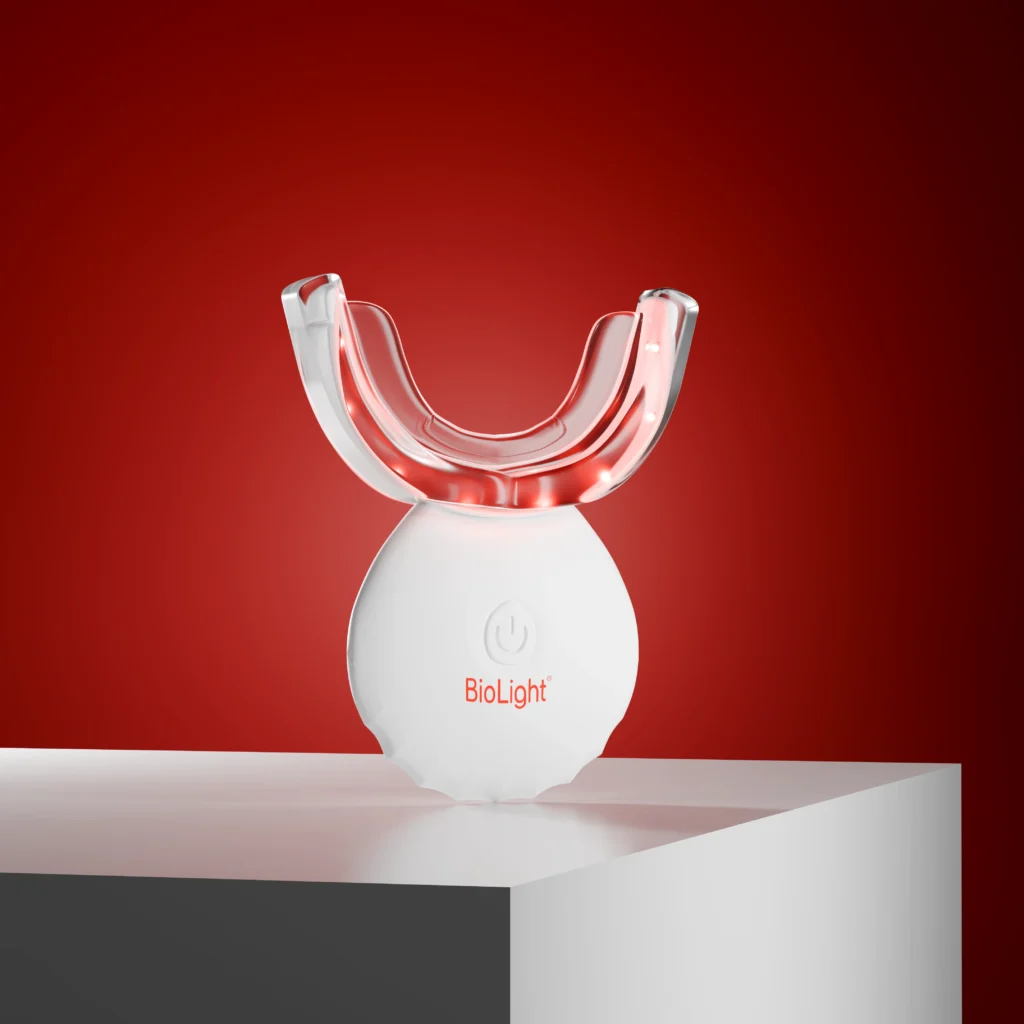
Light. The true charge for our human bodies.

All wavelengths of light have their own benefits, and this blog is going to focus on the healing effects of red and near infrared (NIR) wavelengths. Red wavelengths range from about 630 nm to about 780 nm, and NIR wavelengths range from about 780 nm to 1400 nm. Photobiomodulation (PBM) is the therapeutic application of light to promote tissue repair, reduce inflammation, and relieve pain. PBM utilizes light sources like LEDs and lasers to induce biological responses without causing heat damage.
Longer Red and NIR wavelengths of light are very complementary to healing.
- The more shallow penetrating red wavelengths stimulate blood flow at the surface.
- The deeper penetrating NIR wavelengths activate mitochondria deeper in tissues for improved cellular energy and repair.
Shorter blue light wavelengths (380 to 500 nm) will be included in a few recommendations, as well.
- Blue light also has some therapeutic potential in oral health due to its antibacterial properties and activation of certain chemical compounds, and it will be discussed in a few applications.
- Blue light, however, has a great deal of adverse effects on circadian rhythm and eye health, so you want to be mindful of its use to minimize effects on sleep and vision. Minimize its use in the evening and protect your eyes!
Let’s now dive into how I’d like for my patients to understand the healing power of light! PBM with red and NIR light can be very useful in promoting oral health and healing. Read on to learn more about enhanced oral health and wound healing with frenectomies, oral surgery, periodontal disease, tooth sensitivity, post-operative sensitivity following restorative work, and much more.
Important considerations for optimal PBM therapy results:
- FREQUENCY: Ideally, wait 24 hours between most PBM therapy sessions. 3 to 5x/week is typically going to be a very effective protocol.
- DOSE: Achieving the desired dosage of light energy for the specific treatment is dependent on time of treatment and Irradiance of your particular device.
- Application Time is determined by Energy Density (Desired Dose or Fluence J/cm2) and Irradiance of the device (Power Output mW)
Understand the biphasic dose-response.
- Too little dosage will provide low therapeutic benefit, so you want to make sure you have a good quality device. It is the wild west out there, and there are a lot of companies that are selling products with greatly exaggerated output, so I’ll provide some good quality companies and products for my recommended therapeutic uses.
- Too much or too frequent dosing isn’t going to cause harm, but it will neutralize the benefit of the PBM therapy, returning you to a state of low therapeutic benefit.
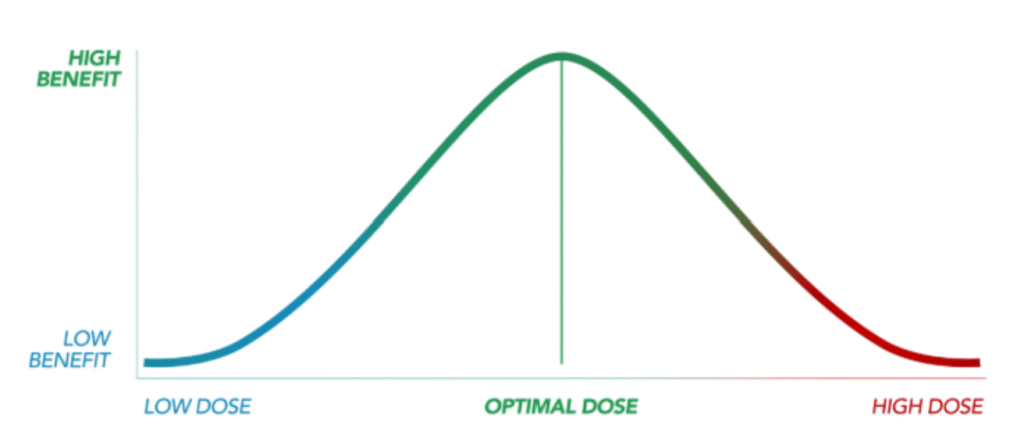
In order to determine the treatment time needed with your specific device, you can use one of these dosage calculators. The inputs that you will need are the Desired Dosage (J/cm for treatment and the Irradiance of your particular R/NIR therapy device. In order to find the irradiance for your device, you will need to refer to its user manual.
-or-
https://neoscience.com/red-light-dose-calculator/
Irradiance is typically reported as the measurement at the surface (meaning that the device is in contact with the treatment area). If you cannot have the device directly in contact with the desired treatment area, then you may need to increase treatment time due to decreased irradiance with increased distance. Keep in mind that, while there are some very good quality red light device companies, there are many that do not utilize third party testing of their products, and thus the irradiance metric that they report is likely over-inflated- sometimes by as much as 250%! If this is the case, desired dosage will not be reached with the calculated treatment time.That doesn’t mean that you can’t treat with these devices, but it does mean that you will not get an effective dose for treatment unless you know this and utilize a much longer treatment time than claimed.
My recommended devices and their uses:
Biolight Guardian or Guardian Plus
**Code ‘drmindy’ for 15% off. My patients get a larger discount, as I am not affiliated with the company and have directed all available discounts to my patients.

What is the difference between the two? The Guardian has Red (630 nm) and NIR (850 nm) wavelengths, and the Guardian Plus has Red (630 nm), NIR (850 nm), and Blue (460 nm) wavelengths.1.2 to 2.2 mW/cm2 output- third party tested.
Note that the therapeutic desired dosages and treatment times will be different with this device than the more focused site-specific devices, due to its more generalized treatment area and lower power.
- Orthodontic patients: The red and NIR wavelengths are very effective in stimulating mitochondria in alveolar bone cells, allowing more efficient orthodontic movement of the teeth with enhanced bone development. You can use the Guardian or the Guardian Plus for this.
- During active orthodontic treatment, use the Red/NIR Mode for 10 minutes each day.
- Periodontal disease or gingivitis: Periodontal disease and gingivitis are inflammatory responses to pathologic bacterial strains. This is when the blue wavelength of the Guardian Plus will be beneficial for its antibacterial activity. The best combination for treatment of these inflammatory conditions is a combination of blue, red, and NIR. Shorter red light wavelengths are more effective for gingivitis, and longer NIR wavelengths penetrate deeper for periodontal disease.
- During active inflammation, use the Red/NIR/Blue Mode for 20 minutes each day for 1 to 2 weeks. (Note you would need the Guardian Plus device for blue)
- For maintenance treatment, use the Red/NIR Mode for 10 minutes, 3x/week.
- Tooth bleaching: This is another use for the Blue wavelength, as it activates the peroxides in bleaching gels to enhance bleaching results. You will therefore need the Guardian Plus for this.
- With the bleach in contact with your teeth, use the Blue Mode for at least 10 minutes of the time that you are bleaching.
- To help with sensitivity, follow this with the Red/NIR mode for 10 minutes after you finish bleaching.
- Generalized tooth sensitivity: The NIR wavelength stimulates pulpal healing and repair, which in turn reduces tooth sensitivity. This device is particularly helpful if multiple teeth are sensitive.
- Use the Red/NIR Mode for 20 minutes a day. Do this 4x/week.
- Dry Mouth (Xerostomia): This is a side effect of many medications. Red/NIR wavelengths can help with stimulation of saliva. Wavelengths between 630 (Red) and 830 (NIR) nm have shown the most promise, with dosage from 2 to 10 J/cm2.
- Use the Red/NIR Mode for 30 minutes, 3x/week
- Oral lesions and mucositis: The Red/NIR wavelengths of this device can be therapeutic for superficial gingival wounds like cold sores and canker sores, oral mucositis, and lichen planus. Dosage 4 to 8 J/cm2.
- During active oral lesions, use the Red/NIR Mode for 30 to 60 minutes (depending on severity of lesions), 5 x/week
Lightpath LED Diesel Torch
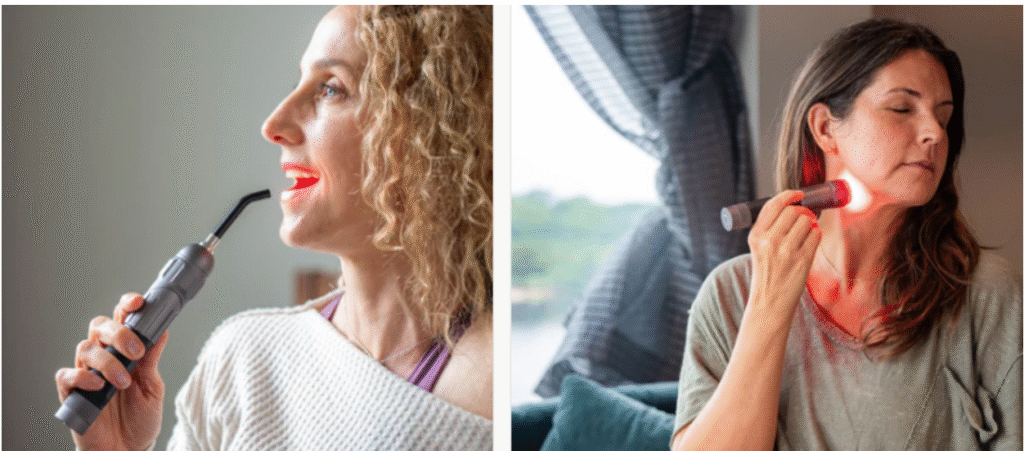
At this point, I find this to be the most versatile and cost effective option for higher output treatment in a number of different situations. The half moon lens allows targeted treatment for skin/joint/muscle anywhere in the body by pressing it into the skin over the site. The intraoral tip is great for treating specific teeth or other intraoral sites with a more intense and effective dose. Outside of the oral and TMJ treatments I highlight below, it can also be used for skin/muscle/joint issues throughout the body. The downside for larger areas is that the treatment size is small so it takes longer to treat larger areas, but the output is effective.
The wavelength combination is Blue (450 nm), Red (620 and 670 nm), NIR (810 nm). The unit has implied 200 mW/cm2 output at the surface with no tip. It has third party verification of 100 mW/cm2 output from the intraoral tip.
The three therapeutic modes are as follows: Mode 1: Red only. Mode 2: Red and NIR. Mode 3: Red, NIR, and Blue.
- Pulpal healing following restorative work or trauma to a tooth: Teeth can be sore and/or hypersensitive following restorative procedures like fillings and crowns or following dental trauma like a tooth getting hit with a baseball. PBM can be very effective in acceleration of relief with this. Deeper penetrating longer wavelength NIR light is going to be most effective at reaching the pulp tissue inside the tooth, allowing it to promote pulpal healing. The desired dose for this is 4 to 10 J/cm2 per tooth.
- Use Mode 2 Red/NIR combo.
- Utilize the Intraoral tip attachment for more precise concentration of energy.
- Main treatment: 90 seconds, 1 x/day for 2 weeks. Treat the tooth by placing the tip on the front side of the bone right over the tooth roots. This will allow the longer NIR wavelength light to penetrate through the root and the thin bone and stimulate pulpal healing.
- Additional option: 90 seconds, 1 x/day for 2 weeks. If the tooth is not covered by a ceramic crown, hold the tip directly on the front of the tooth itself. Note that treating from the front side of the tooth is more effective than shining it down from the top, as the enamel and dentin tooth structure is thicker on the top of the tooth, which blocks penetration of the therapeutic light waves from reaching the pulp inside the tooth. Similarly, a crown covering a tooth will block penetration.
- Site-specific tooth sensitivity: Red and NIR light therapy for dentin hypersensitivity is effective and results can last for months. Wavelengths: Red and NIR. The desired therapeutic dose is 2 to 4 J/cm2 per location.
- Use Mode 2 Red/NIR combo.
- Place the Intraoral tip right at the gumline on the front of the sensitive tooth. Use the Red/NIR mode for 40 seconds per site every other day for one to two weeks, or until the sensitivity resolves.
- Localized Periodontal Disease: This smaller and much more powerful device is very effective at treating specific areas of advanced periodontal disease, in contrast to the full mouth yet lower output Guardian Plus device. Longer NIR wavelengths penetrate deeper for periodontal healing, and the addition of blue wavelengths for antibacterial properties are also beneficial. Desired dose is 20 J/cm2 per area.
- Use the Intraoral tip directly over the bone in front of the desired tooth.
- Treat each site for 3 and a half minutes.
- For the first 2 weeks, use Mode 3 Blue/Red/NIR 5x/week.
- For maintenance thereafter, use Mode 2 Red/NIR 3x/week.
- Xerostomia (Dry Mouth): Near Infrared (NIR) longer wavelengths (810 to 830 nm), applied intraorally and/or extraorally, have consistently been very effective for improvements in salivary flow for those with health conditions or medication side effects causing xerostomia. The slightly shorter Red wavelengths (660 nm) have also shown some improvement when applied intraorally.
- The key to effective treatment is application of the therapeutic light as close to the glands as possible. Start with an understanding of where the main salivary glands (parotid, sublingual, submandibular) are located.
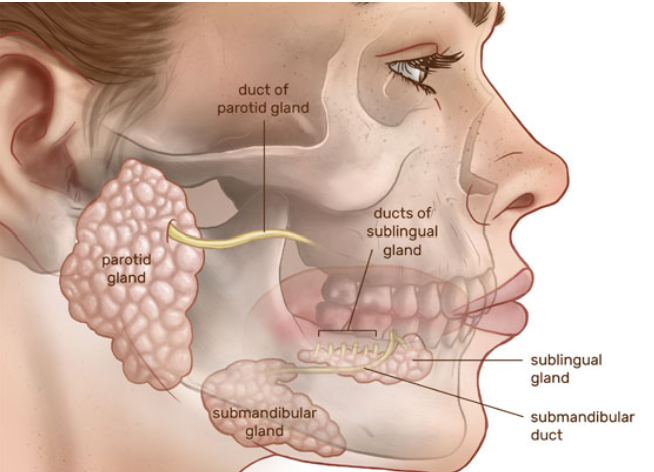
- Use Mode 2 for Red/NIR combo.
- Perform PBM treatment of the salivary glands 3 x/week. Treat each site for a dosage of around 24 J/cm2. With this device, it equates to 3 minutes per site. With a total of 5 sites, this would be a total treatment time of 15 minutes.
- 2 sites: Treat the right and left parotid glands extraorally with the half moon lens pressed into the skin in front of the earlobe.
- 2 sites: Treat the right and left submandibular glands extraorally with the half moon lens pressed into the skin of the floor of the mouth inside the mandible, just anterior to the jawline.
- 1 sites: Treat the right and left sublingual glands extraorally as 1 site. Treat the sublingual glands extraorally with the half moon lens pressed into the skin of the floor of the mouth just behind the skin.
- As an alternative to extraoral treatment of the sublingual glands, you could treat intraorally as 2 sites. Treat the right and left sublingual glands intraorally with the intraoral tip directed under the tongue, right side then left side.
- Pain Reduction following oral surgery: Longer penetrating NIR (810 to 880 nm) wavelengths are going to be most effective for pain reduction. Total desired dosage per surgical site is about 66 J/cm2.
- To avoid excessive bleeding, do not treat for the first 3 days following surgery.
- Use Mode 2 Red/NIR combo for days 4 through 7 following surgery.
- Press the Half Moon lens on the cheek skin directly in front of the extraction site. Treat for 6 minutes 1x/day, in modes indicated above, for a week following surgery.
- Discomfort before and after root canals: Longer penetrating NIR (810 to 880 nm) wavelengths are going to be most effective for pain reduction. The added incorporation of Red wavelengths will increase local blood supply to aid in healing. Total desired dosage per tooth is about 9 J/cm2, half from the bone in front of the tooth roots, half from the bone in back of the tooth roots.
- Use Mode 2 for Red/NIR combo.
- Using the Intraoral tip, place the end directly on the bone of the front side of the tooth roots for 1 minute, then on the bone at the back side of the tooth roots for 1 minute.
- Treatment of oral lesions: Red and NIR combo is best for treatment of oral lesions, such as aphthous ulcers (canker sores). Research has shown significant reduction in pain, size, inflammation, and healing time of ulcers in the PBM group vs placebo groups. Desired dosage is 6 to 12 J/cm2 per lesion.
- Use Mode 2 Red/NIR combo.
- Using the Intraoral tip, place the end directly in contact with the ulcer. Treat each individual lesion for 1 to 2 minutes, 1x/day every other day until healed.
- TMJ pain and dysfunction: NIR wavelengths are the most effective for deeper muscle and joint discomfort, while Red wavelengths are a helpful adjunct with outcome of increased bloodflow. Desired dosage is 50 to 60 J/cm2. It is important to realize that TMJ dysfunction is a multifactorial issue, and this will not cure a TMJ problem, but the aim here is to reduce discomfort.
- Use Mode 2 Red/NIR combo.
- Using the Half Moon lens, press it into the skin directly in front of the tragus of the ear, which will be directly over the jaw joint. Treat for 5 to 7 minutes over each joint. Do this 4x/week.
- Healing after soft tissue procedures such as frenectomy or gingivectomy: The combination of Red and NIR wavelengths have shown accelerated healing, reduced pain, and improved epithelialization as compared to control groups in the research for oral wound healing following soft tissue surgery. Desired dosage is about 8 J/cm2.
- Use Mode 2 Red/NIR combo.
- Using the Intraoral tip, place the end as close as possible to the surgical site. Treat each surgical site for 90 seconds. Do this every other day for 5 weeks.Treating for the full 5 weeks is helpful in the reduction of scar tissue formation.
- Nasal and sinus congestion: Blue light is beneficial for its antibacterial properties here. Red and NIR improve oxygenation, reduce inflammation, and boost innate immunity. Desired dosage for nasal congestion intranasal therapy is about 6 J/cm2. The desired dosage for maxillary sinus congestion external therapy is about 10 J/cm2.
- Use Mode 3 Red/NIR/Blue combo.
- For sinus congestion, you will use the Half Moon lens. Press into the skin just inferior to the cheekbone, in the area above the upper molars. Treat the left and right sides each for 90 seconds. Do this 5x/week as needed.
- For nasal congestion, you will use the Intraoral tip. You will insert the tip into your nostril as far as it will comfortably go, no further. After use, the tip can be disinfected with gauze or paper towel soaked in rubbing alcohol. Treat each nostril for 1 minute. Do this 5x/week as needed.
- Swollen tonsils and adenoids: Due to the bacterial nature of tonsillitis and adenoiditis, using anti-bacterial Blue light in addition to the healing Red and NIR wavelengths is desirable. There is only limited research of this specific treatment, but common sense with the therapeutic knowledge we have can be paired with the limited data available to recommend targeted therapeutic protocols. Desired dosage would be 10 to 15 J/cm2 per site.
- Use Mode 3 Red/NIR/Blue combo.
- Treat the right and left tonsils as separate sites. Using the Intraoral tip, get the end as close as you comfortably can to the tonsil. Treat each tonsil for 2 minutes. Do this 5x/week as needed.
- Treat the adenoids as one site by targeting the end of the Intraoral tip to the soft palate, as the adenoids lie just above the soft palate. Treatfor 2 minutes. Do this 5x/week as needed.
MitoBOOST Intranasal Device/Sinus Health
**Code ‘drmindy’ for 15% off. My patients get a larger discount, as I am not affiliated with the company and have directed all available discounts to my patients.
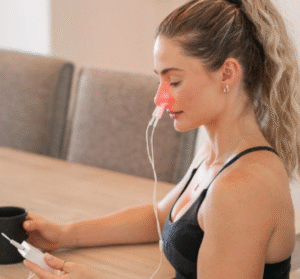
This is a highly specialized device with more limited uses, but it is a very convenient mode of treatment for those with chronic nasal and sinus congestions. It has two wavelengths, antibacterial Blue at 450 nm and healing anti-inflammatory Red at 650 nm.
3 Modes. M1 is Red/Blue. M2 is Red only. M3 is Blue only.
- Nasal and sinus congestion: Blue light is beneficial for its antibacterial properties. Red reduces inflammation and improves oxygenation.
- Use at 100% intensity on M1 mode.
- One nasal probe will emit Red light, the other will emit Blue light. For this reason, remember to rotate the nasal probes halfway through treatment each time.
- The first week, start with 10 minutes total treatment time.
- The second week and thereafter, go up to 20 minutes total treatment time.
- Treat 4x/week..
Great resources to learn more:
- Huberman Lab Podcast: Using Light (Sunlight, Blue Light & Red Light) to Optimize Health
- Dr. Glen Jeffery, PhD, from Stanford discussing red light therapy: Red Light Therapy Improves Mitochondria Function, Eye Health, And Lifespan: Glen Jeffery, PhD
- Dr. Jack Kruse, MD on the Take a Deep Breath Podcast: Health is about Light NOT Food
- Dr. Michael Hamblin, professor at Harvard and Principal Investigator at the Wellman Center for Photomedicine at Massachusetts General Hospital: Red LIght Science DEEP DIVE
One more thing…
To maximize the benefits of photobiomodulation, be sure your body has what it needs to handle the increased cellular energy and efficiency.
- Have proper B vitamin complex for ATP formation uptick.
- Healthy fats like fish oil for neuron formation.
- Antioxidants Vitamin C and CoQ10 to handle uptick in ROS from increased ATP formation.
- Good glutathione support, with sulfur rich veggies like broccoli, cauliflower, onions, garlic, etc..
Photobiomodulation is truly a remarkable therapeutic modality, and I encourage you to learn more about it. Aside from the oral and craniofacial benefits I detail above, PBM has so much benefit for mood, skin health, muscle recovery, vision, brain health, you name it. Use some of the credible sources that I share in the resources above and get after it;).
✌️
~Dr. Mindy
